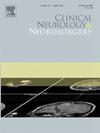IDH突变胶质瘤T2-FLAIR错配征假阳性和假阴性的临床病理学和放射学特征
IF 1.8
4区 医学
Q3 CLINICAL NEUROLOGY
引用次数: 0
摘要
目的 探讨利用T2-流体加权反转恢复(FLAIR)错配征在胶质瘤中识别异柠檬酸脱氢酶(IDH)突变时,与假阳性和假阴性结果相关的临床病理学和放射学特征。方法 利用术前磁共振成像对1515例脑胶质瘤患者的肿瘤位置、弥散加权成像的局限性弥散以及T2-FLAIR错配征进行回顾性分析。此外,还得出了 T2-FLAIR 错配征的假阳性和假阴性结果。结果总体假阳性率为 3.5 %(53/1515),其独立风险因素是患者的年龄(调整后比值比 [OR],0.977;95 % 置信区间 [CI],0.957,0.997;P = 0.027)和非限制性弥散(调整后比值比 [OR],1.968;95 % 置信区间 [CI],1.060,3.652;P = 0.032)。总体假阴性率为 39.7%(602/1515);其独立风险因素是患者的年龄(调整后 OR,1.022;95 % CI,1.005,1.038;P = 0.008)、1p/19q 共缺失(调整 OR,3.334;95 % CI,1.913,5.810;P <;0.001)和端粒酶逆转录酶启动子突变(调整 OR,2.004;95 % CI,1.181,3.402;P = 0.010)。对于特发性 IDH 的错配标志,接收者操作特征曲线下面积(AUC)为 0.602。结论临床病理学和放射学特征可导致根据 T2-FLAIR 错配征误判胶质瘤的 IDH 状态。但是,如果仔细观察,这种情况是可以避免的。本文章由计算机程序翻译,如有差异,请以英文原文为准。
Clinicopathological and radiological characteristics of false-positive and false-negative results in T2-FLAIR mismatch sign of IDH-mutated gliomas
Purpose
To explore the clinicopathological and radiological characteristics associated with false-positive and false-negative results in the identification of isocitrate dehydrogenase (IDH) mutations in gliomas using the T2-fluid-attenuated inversion recovery (FLAIR) mismatch sign.
Methods
In 1515 patients with cerebral gliomas, tumor location, restricted diffusion using diffusion-weighted imaging, and the T2-FLAIR mismatch sign were retrospectively analyzed using preoperative magnetic resonance imaging. Moreover, both the false-positive and false-negative results of the T2-FLAIR mismatch sign were obtained. Univariate and multivariate logistic analyses were performed to evaluate the risk factors associated with false-positive and false-negative results.
Results
The overall false-positive rate was 3.5 % (53/1515), and its independent risk factors were the patient’s age (adjusted odds ratio [OR], 0.977; 95 % confidence interval [CI], 0.957, 0.997; P = 0.027) and non-restricted diffusion (adjusted OR, 1.968; 95 % CI, 1.060, 3.652; P = 0.032). The overall false-negative rate was 39.7 % (602/1515); its independent risk factors were the patient’s age (adjusted OR, 1.022; 95 % CI, 1.005, 1.038; P = 0.008), 1p/19q co-deletion (adjusted OR, 3.334; 95 % CI, 1.913, 5.810; P < 0.001), and telomerase reverse transcriptase promoter mutation (adjusted OR, 2.004; 95 % CI, 1.181, 3.402; P = 0.010). For the mismatch sign in idiopathic IDH, the area under the receiver operating characteristic curve (AUC) was 0.602. The combined AUC for the T2-FLAIR mismatch sign and risk factors was 0.871.
Conclusions
Clinicopathological and radiological characteristics can lead to the misinterpretation of IDH status in gliomas based on the T2-FLAIR mismatch sign. However, this can be avoided if careful attention is paid.
求助全文
通过发布文献求助,成功后即可免费获取论文全文。
去求助
来源期刊

Clinical Neurology and Neurosurgery
医学-临床神经学
CiteScore
3.70
自引率
5.30%
发文量
358
审稿时长
46 days
期刊介绍:
Clinical Neurology and Neurosurgery is devoted to publishing papers and reports on the clinical aspects of neurology and neurosurgery. It is an international forum for papers of high scientific standard that are of interest to Neurologists and Neurosurgeons world-wide.
 求助内容:
求助内容: 应助结果提醒方式:
应助结果提醒方式:


